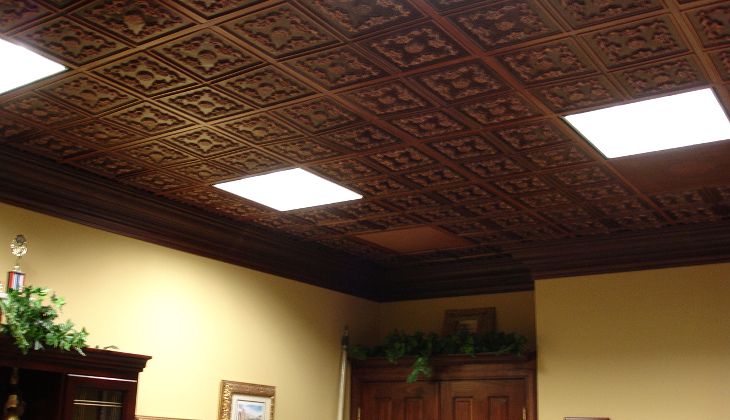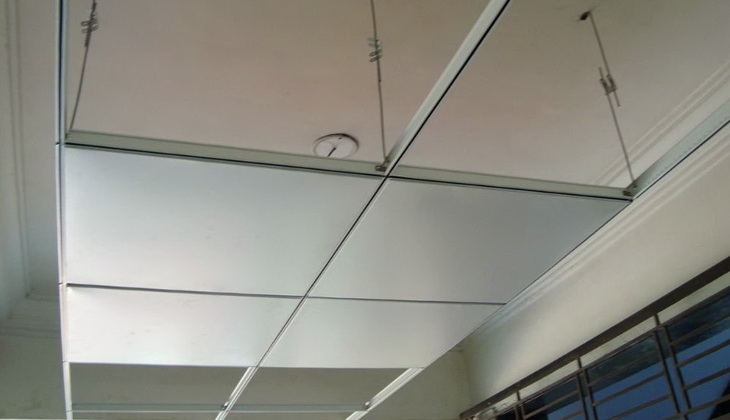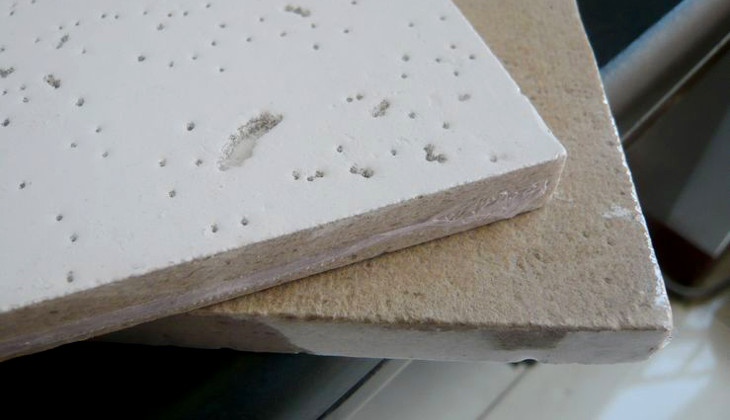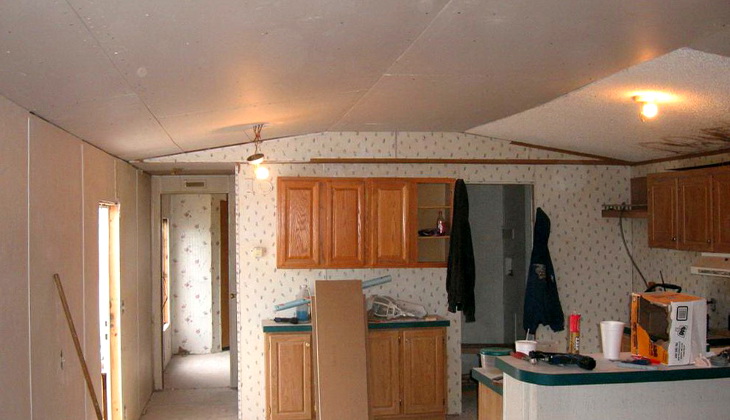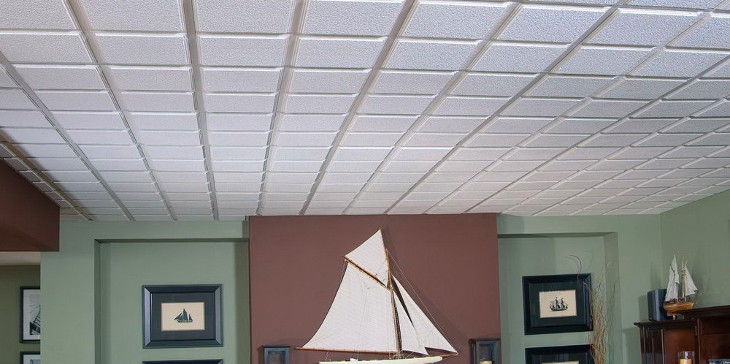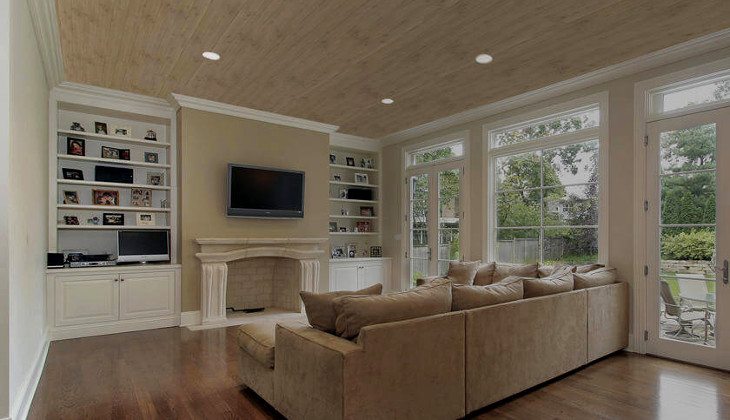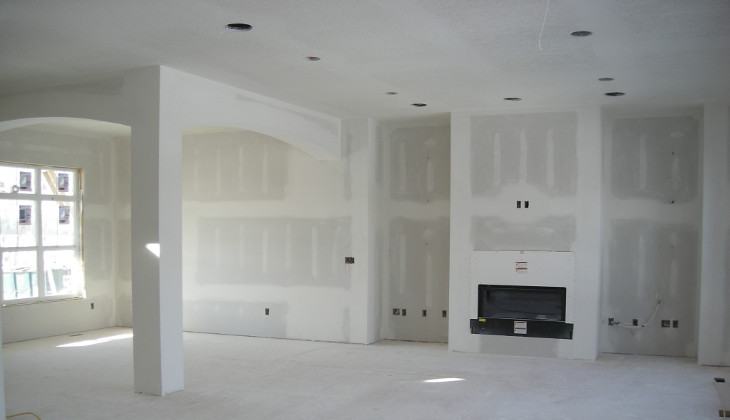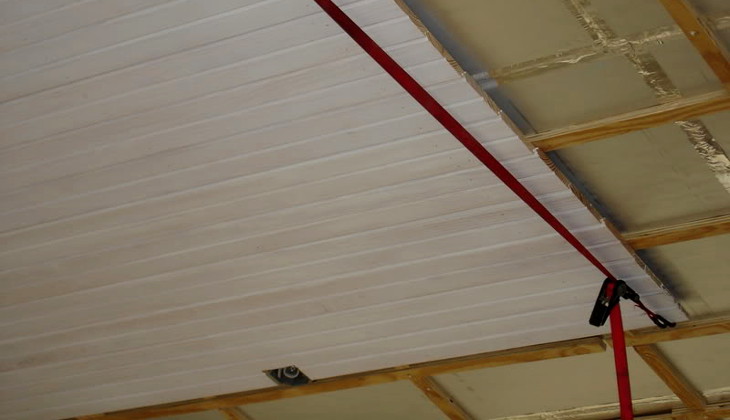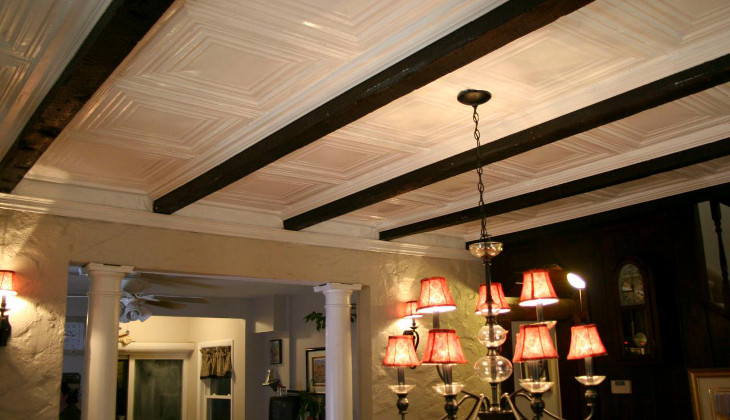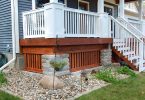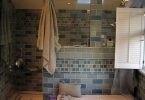There is a huge variety of mobile home ceiling panels to choose from, but what if you need to replace them? Have you ever thought of how much that would cost you or how to pick the right panels?
In this article we are going to get you familiar with different types of ceiling panels, including some basic tips on how to repair and maintain them. In order to make your home more pleasing to the eye and more durable, you need to choose wisely.
Types of Ceiling Materials for Mobile Homes
When it comes to choosing a material for your new ceiling, you can basically choose any material that comes to your mind. However, in order to make your ceiling both practical and aesthetically appealing, you need to learn different types of materials. So let’s take a look at some of them now:
- Drywall. Also known as Gypsum Board, Wallboard or Sheetrock, this is a type of material that is in a form of tiles. It is made of gypsum, a natural mineral. One of the best advantages of using gypsum is that it is completely waterproof and fire retardant. That means that you can stay assured that it won’t melt away or leak though. Additionally, drywall can be picked from a huge range of textures to make your ceiling more interesting and unique.
- Lumber. This material certainly gives off a kind of rustic vibe, and many people enjoy wood. Lumber is usually made of pine and it is of light brown color, but it can be painted and made of various patterns. It is recommended to use it together with drywall so you can achieve the fire retardant feature.
- Acoustical material. Materials such as wood fiber reduce noise. This kind of fiberglass blend material is able to absorb noise and make your living more comfortable. One of the disadvantages is that this type of material is not practical in humid circumstances. There are many other ways to reduce noise and they are mostly costly.
- Tin, cork, copper, plastic tiles etc. Plastic is the cheapest because it is the easiest to be made. Metal is very difficult to cut while cork is environmentally friendly. It is up to your preference and budget to choose the material you find suitable for your mobile home.
The Cost of Replacing Mobile Home Ceiling Panels
As you probably already know, it is usually cheaper to get your ceiling panels from the manufacturer because the cost is already part of the package. However, if you wish to replace the existing ceiling panels because they got damaged or you simply do not like them anymore, you might face difficulties. Let’s take a look at different types of materials and their prices.
Fiberboard
Fiberboard is a type of specific engineered wood material that is made of wood fibers and usually made of huge panels. As you can imagine, that is what it makes it so hard to replace. Manufacturers tend to change their materials as the years pass by and when you decide to change the panels you might not be able to source them anymore.
Your best chance is to try to find the closest matching material or panel that resembles your ceiling. Fiberboard is known for its durability and safety. A price of one panel is approximately $110.
Drywall
The price of drywall is usually around $16 per panel because this type of material is easy to fix and it can be found anywhere. Drywall is known for its durability, sturdiness and water resistance. Besides them, we have already mentioned that this material possesses fire resistant control as well, which makes it amazing and affordable. It is no wonder that so many people use it in their homes.
Ceiling Tiles
Ceiling tiles are usually sold at $5 per tile, which makes them the cheapest in the market. Most of the tiles are held with rosettes and screws and there can be a variety of types. However, if you damage a tile, it can be very difficult to replace it.
As with fiberboards, getting the matching one is sometimes impossible, especially if a long time has passed since your initial purchase. That is why many home owners are sometimes forced to replace the entire ceiling which can be very costly.
Tips on Making Your Mobile Home Ceiling Taller
Many mobile home owners complain that their standard manufactured ceiling are not tall enough. The standard height is 7 feet and even though this is cozy and normal, sometimes it is not enough if you would like your home to appear more glamorous.
We are going to show you a couple of tips and tricks on how to make your manufactured ceiling appear taller, thus making your home more spacious. Let’s take a look at them here:
- Insert vertical wall panels. It may be hard to believe, but there is a good reason why so many people love installing vertical wood paneling. That is because vertical panels and lines create an illusion of bigger space, thus the room seems more spacious to your eye. Some mobile homes have manufactured wood paneling, but if yours do not, you can install it.
- Paint your room with high gloss white paint. Some say that a matte paint is better; however, it is the high gloss white paint that makes the surface disappear because it adds a reflective sheen to the room and make it larger and taller.
- Get a taller door. Many mobile homes have narrow manufactured doors that seem odd and make the rooms even smaller. If that is the case with you too, then you should get a wider or taller door if there is a possibility of installing them. A taller door will always create an illusion of a taller room.
- Put paintings and photos on your walls. It might seem strange, but it is perfectly logical. Vertical paintings and photo groupings will make the walls seem taller, which makes the ceiling seem taller as well. It would be for the best if you could put a grouping of small objects (photos, paintings, etc.) together on a wall. You will notice the difference immediately.
- Avoid hanging lights. If you have a fan that circulates the air flow in your mobile home, then choose the model that is not hanging very far from the ceiling.
- Hang curtains close to the ceiling. A good rule of thumb is to hang them no more than two inches from the ceiling. If you make the curtain rod out of sight as well, then the ceiling will appear taller.
- Do not make your chair railings taller than 28 inches. The function of railings is to divide the walls in a proportional manner, but a mobile home ceiling can appear even shorter if its railings are too tall.
- Fit furniture into the first third of the room height. This will make your room appear bigger and higher.
- Get floor length mirrors. They will add reflection to the room and create vertical lines that will trick the eye into thinking that the ceiling is taller.
- Use colors and uplighting. It has become popular to use the so called ombre paint techniques that consist of dark colors at the bottom of the walls and the lightest at the top. Our eyes are naturally attracted to bright colors. Therefore, if you add bright colors at the bottom of the walls or your floor, the ceiling will appear higher.
Mobile Home Ceiling Replacement or Repair
Repairing a ceiling of any kind can be very costly and challenging, especially if you need to repair or completely replace the manufactured ceiling panels. As we already mentioned, it might be too difficult or even impossible to find a suitable replacement so you would need to find the closest match and then adjust it to your existing panels.
If you are not experienced enough to do it by yourself, it is always better to ask for professional help.
What are the signs that you need to replace your ceiling as fast as possible? First of all, pay close attention to any brown spots or leakages on your ceiling because they might be a sign that you have got moisture in your home. This can be very dangerous for your family, so you should repair it as soon as you can. The same applies to algae and missing shingles.
Secondly, if your home ceiling is already too old and dilapidated, then you might start thinking of replacing it. If you do not, it might lead to the ceiling becoming more and more vulnerable to moisture and leakage. Now let’s take a look at some concrete tips:
How to Repair Your Ceiling Using by Suspended Ceilings
Using suspended ceilings is one of the cheapest options. You have probably already given up on finding the matching gypsum or fiberboard panels and in that case going for the suspended ceiling is the best option. This kind of ceiling is set in a grid pattern that consists of two by two or two by four. In order to replace it, you need to remove your old ceiling if it is too damaged or hanging.
However, if it is not, then just install the suspended ceiling below the old one. Depending on where you purchased the suspended ceiling the instructions differ.
How to Repair Fiberboard Ceilings
Fiberboard has been praised many times, but we also mentioned that it is difficult to work with it. Additionally, it is expensive because it consists of huge panels that are not replaceable and it can strain your budget too much. In order to replace it, you have to choose a type of panel that resembles yours at least a bit so you can cover the differences later on by painting them.
How to Repair Your Ceiling by Using Sheetrock
Sheetrock is one of the heaviest materials that is sometimes used for repairs. That means that it involves a lot of supports and joints because of its weight.
In order to achieve better safety, many decide to screw the furring strips across the whole ceiling support, which makes it more durable.
How to Repair Your Textured Gypsum Ceiling
Gypsum is also not an easy material to trifle with. Textured gypsum wallboard ceilings also consist of large panels and they rarely match each other. You must find the closest match and then adjust it by painting over it.
How to Repair Your Popcorn Ceiling
A popcorn ceiling is the easiest to repair because all you need to do is scrape the texture off. After that, you just need to paint over it and install the drywall tape. However, if you need to remove the whole ceiling before it, then it is recommended to ask for a professional to do it, especially if the ceiling contains asbestos, a poisonous chemical.
Important Notes
Here are a few final things to keep in mind dealing with mobile home ceiling panels:
- Make sure to inspect your ceiling frequently in order to notice any damage or moisture on time
- If you want to replace the old ceiling, it is better if you find the closest match to it
- Consider asking for professional help. It is more expensive but safer and faster
- Choose the material panels that suit your preference, but make sure that they are durable
Final Thoughts
To sum up, we have talked about different types of ceiling material for mobile home, some advice on repairing and replacing the existing ceiling panels, the cost of this process and some tips on making your ceiling taller. A ceiling is the important part of your mobile home, not only because of its practical functionality but aesthetically speaking as well.
If you already have a manufactured ceiling then you can adjust the interior of the room in order to make the ceiling more appealing to the eye, thus making the room seem more spacious and cozy.
When it comes to repairing and replacing, it is always better to be safe than sorry so do not do anything by yourself if you are not experienced. It might be better to pay more for professional help than hurt yourself or damage the ceiling even more.
Have you ever repaired your ceiling before? What type of ceiling material do you have or which type would you like to get? Are there any tips on making the ceiling higher that you would like to share with us?
Thanks for reading and if you have any questions, feel free to ask them in the comment section below.

